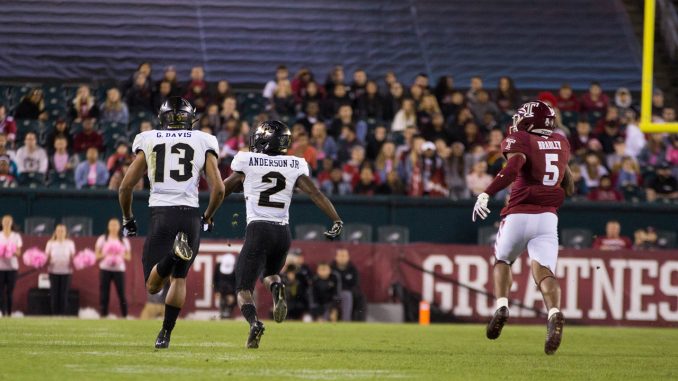
Temple football’s defense has allowed 1,269 total yards and 108 points in the last two games.
The Owls (5-3, 2-2 The American Athletic Conference) have lost two straight games by a combined total of 66 points because the Owls secondary has given up too many big plays.
On Oct. 15, I wrote that Temple’s defense would be facing its biggest challenges of the season against Southern Methodist (8-0, 4-0 The AAC) and then against Central Florida (6-2, 3-1 The AAC). I believed if the Owls defense could hold the Mustangs and Knights in check then they should be considered one of the best defenses in the country.
The Owls failed to do that as they gave up 614 total yards and 63 points against the Knights in their first home loss of the season on Saturday night. They gave up 655 total yards against the Mustangs on Oct. 19.
Temple’s defense has been unsuccessful because their scheme puts too much pressure on its cornerbacks and safeties.
The Owls’ coaching staff needs to adjust their formations and play-calling to prevent cornerbacks from being isolated in coverage against receivers with no support from safeties. When a corner is isolated against a receiver, the receiver only has one player to beat to score a touchdown.
Against the Knights, Temple’s defense allowed five touchdowns longer than 20 yards, including a 73-yard touchdown pass to junior receiver Marlon Williams.
Temple graduate safety Ayron Monroe, who was playing cornerback against Williams, allowed Williams to get open and then was unable to tackle him. Because Monroe was in one-on-one coverage, Williams was able to run untouched into the endzone.
Temple’s defense would benefit from putting an extra cornerback on the field to cover opposing teams’ slot receivers instead of forcing a safety to play out of position.
Doing this would allow Temple to use its safeties to support its corners, instead of forcing them to cover receivers in one-on-one coverage.
Temple allowed the Mustangs’ leading receiver junior Reggie Roberson Jr. to compile 250 yards and three touchdowns against them. Nothing changed on Saturday against the Knights’ leading receiver junior Gabriel Davis.
Davis had three catches for 83 yards in the game, all of which came against one-on-one coverage where the cornerback was unable to cover Davis.
Based on the numbers, it may seem as though Temple’s defense improved, but Knights freshman quarterback Dillon Gabriel overthrew Davis multiple times when he was wide open.
Gabriel threw three touchdowns in the game where Knights’ receivers beat the Owls’ corners in one-on-one coverage.
The coaching staff’s lack of flexibility cost Temple 21 points on Saturday and could have cost more if not for Gabriel’s overthrows.
It’s impossible to assign two defenders to every receiver on every play, but when the same receiver beats you multiple times for plays longer than 20 yards, it’s time to try something different.
Early in the season, Temple was able to get away with not helping its corners because they played teams who didn’t try to challenge them down the field with big plays.
Now that the team is four games into conference play, they need to start making adjustments to counter where they have struggled so far.
If they don’t adjust, Temple will continue to give up big plays in the passing game and will continue to lose in blowout fashion.



Be the first to comment